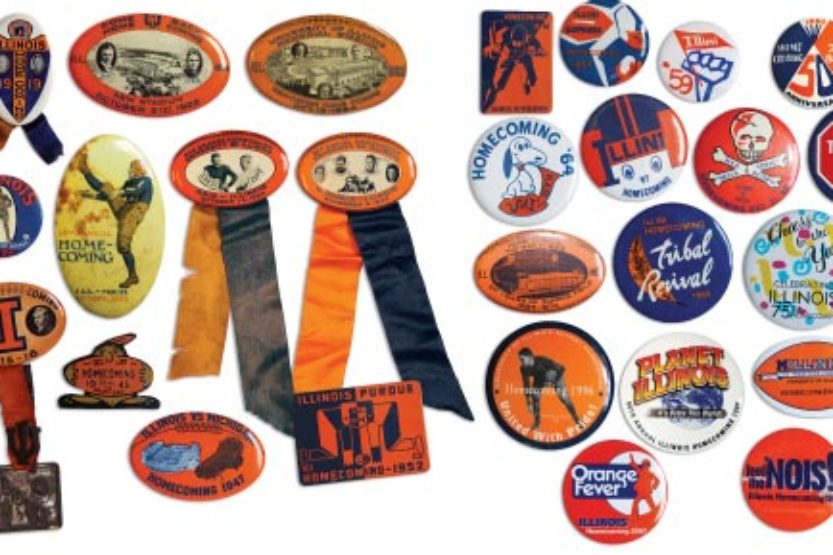Illini Spirit

They’re as old as Homecoming itself, and their ever-changing designs mirror the history of the annual event.
Since a pin was created for the first Homecoming at the University of Illinois in 1910, Illini have donned lapel decorations when celebrating the return to Alma Mater each fall. These Homecoming badges have honored athletic greats, such as Harold “Red” Grange ’26 and football coach Bob Zuppke ’38, and marked important University events, including the dedications of Memorial Stadium, the Illini Union and Assembly Hall.
They have also reflected events beyond campus. During World War II, the traditional metal badges (commonly called “buttons” today) were abandoned in favor of cardboard orbs to conserve money. In 1970, the badge featured the words “WHEN THE BOYS COME HOME” on a stop sign shape, alluding to the Vietnam War. Some buttons also represented cultural trends of their era, such as 1945’s parody of the ubiquitous Kilroy figure and the cartoon dog Snoopy in 1964.
“[The buttons] reflect both the larger popular culture and attitudes on campus as well,” says Ellen Swain, ms ’95 lis, archivist at the University’s Student Life and Culture Archival Program.
Collecting the buttons has become quite a pastime for several alumni, including Jayne Turpin DeLuce ’87 AHS, MS ’88 AHS; David Dorris JD ’73 LAW, of LeRoy; Don Long ’59 BUS of Lake Wylie, S.C.; Phil Matteson ’57 BUS of Champaign; Kevin McCandless ’01 AHS, MS ’02 AHS, of Urbana; andPaul L. Stone ’67 BUS, JD ’70 LAW, of Sullivan.
Long’s inventory of UI memorabilia includes approximately 600 buttons and pins, 80 of which are Homecoming badges.
Despite the variety of designs over the years, the wording on Homecoming badges is usually more standardized, he says.
“The Homecoming pins tend to be very straightforward,” Long says. “They tend to have the name or slogan that’s been chosen, and that’s about it.”
Nonetheless, the buttons’ changing shapes, colors, details and themes continue to commemorate the mood of Homecoming days gone by.
And, Swain notes, they’ve become “very orange since 2005.”

